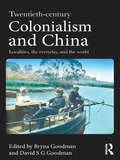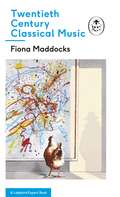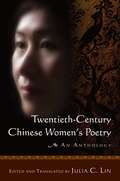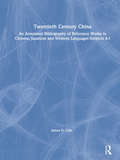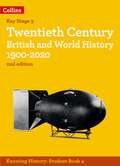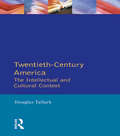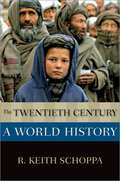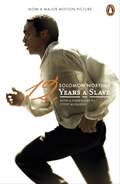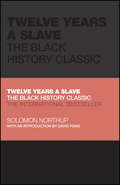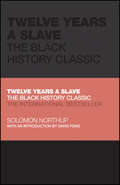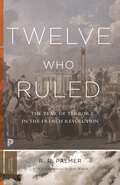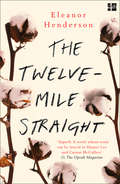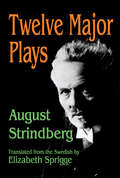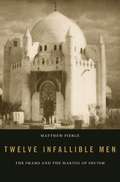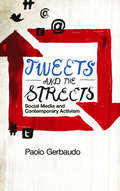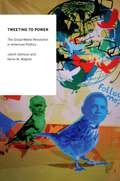- Table View
- List View
Twentieth Century Colonialism and China: Localities, the everyday, and the world
by Bryna Goodman David S. G. GoodmanColonialism in China was a piecemeal agglomeration that achieved its greatest extent in the first half of the twentieth century, the last edifices falling at the close of the century. The diversity of these colonial arrangements across China’s landscape defies systematic characterization. This book investigates the complexities and subtleties of colonialism in China during the first half of the twentieth century. In particular, the contributors examine the interaction between localities and forces of globalization that shaped the particular colonial experiences characterizing much of China’s experience at this time. In the process it is clear that an emphasis on interaction, synergy and hybridity can add much to an understanding of colonialism in Twentieth Century China based on the simple binaries of colonizer and colonized, of aggressor and victim, and of a one-way transfer of knowledge and social understanding. To provide some kind of order to the analysis, the chapters in this volume deal in separate sections with colonial institutions of hybridity, colonialism in specific settings, the social biopolitics of colonialism, colonial governance, and Chinese networks in colonial environments. Bringing together an international team of experts, Twentieth Century Colonialism and China is an essential resource for students and scholars of modern Chinese history and colonialism and imperialism.
Twentieth-Century Classical Music: A Ladybird Expert Book (The Ladybird Expert Series)
by Fiona MaddocksPart of the ALL-NEW LADYBIRD EXPERT SERIES.____________How did modern classical music develop over the 20th Century?What enabled women to get their music performed in the early 1900s?Which classical composers borrowed from jazz?How did composers respond to politics and war?DISCOVER the stories behind Mahler's, Symphony No. 5 (1901-2), Ullman's Piano Sonata No. 7 (1944), Bernstein's West Side Story (1957), as well as learn about minimalism, jazz, swing, opera . . . AND UNDERSTAND TWENTIETH CENTURY CLASSICAL MUSIC.Discover the answers and more inside Fiona Maddocks' Twentieth Century Classical Music, the thrilling and accessible account that explains what happened throughout the 20th century, who the key composers were and what influenced them to write what they did?
Twentieth-century Chinese Women's Poetry: An Anthology
by Julia C. LinChinese women's writing is rich and abundant, although not well known in the West. Despite the brutal wars and political upheavals that ravaged twentieth-century China, the ranks of women in the literary world increased dramatically. This anthology introduces English language readers to a comprehensive selection of Chinese women poets from both the mainland and Taiwan. It spans the early 1920s and the era of Republican China's literary renaissance through the end of the twentieth century. The collection includes 245 poems by forty poets in elegant English translations, as well as an extensive introduction that surveys the history of contemporary Chinese women's poetry. Brief biographical head notes introduce each poet, from Bin Xin, China's preeminent woman poet in the early Republican period, to Rongzi, a leading poet of modern Taiwan. The selections are startling, moving, and wide-ranging in mood and tone. Together they present an enticing palette of delightful, elegant, playful, lyric, and tragic poetry.
Twentieth-century Chinese Women's Poetry: An Anthology
by Julia C. LinChinese women's writing is rich and abundant, although not well known in the West. Despite the brutal wars and political upheavals that ravaged twentieth-century China, the ranks of women in the literary world increased dramatically. This anthology introduces English language readers to a comprehensive selection of Chinese women poets from both the mainland and Taiwan. It spans the early 1920s and the era of Republican China's literary renaissance through the end of the twentieth century. The collection includes 245 poems by forty poets in elegant English translations, as well as an extensive introduction that surveys the history of contemporary Chinese women's poetry. Brief biographical head notes introduce each poet, from Bin Xin, China's preeminent woman poet in the early Republican period, to Rongzi, a leading poet of modern Taiwan. The selections are startling, moving, and wide-ranging in mood and tone. Together they present an enticing palette of delightful, elegant, playful, lyric, and tragic poetry.
Twentieth Century China: An Annotated Bibliography of Reference Works in Chinese, Japanese and Western Languages
by James H. ColeThis bibliography of reference works from Chinese, Japanese and Western language sources covers: the 1911 Revolution; the Republic of China (1912-1949); the People's Republic of China (1949 onwards); post-1911 Hong Kong and Macau; and post-1911 overseas Chinese. Filled with helpful checklists, charts, and suggestions for further reading, this practical, comprehensive, and multidisciplinary guide takes readers through the entire case-writing process, including skills for writing both teaching cases and research cases. This edition includes new discussions of students as case writers, and how to interpret and respond to reviews, as well as updated and expanded material on video, multimedia and Internet cases.
Twentieth Century China: An Annotated Bibliography of Reference Works in Chinese, Japanese and Western Languages
by James H. ColeThis bibliography of reference works from Chinese, Japanese and Western language sources covers: the 1911 Revolution; the Republic of China (1912-1949); the People's Republic of China (1949 onwards); post-1911 Hong Kong and Macau; and post-1911 overseas Chinese. Filled with helpful checklists, charts, and suggestions for further reading, this practical, comprehensive, and multidisciplinary guide takes readers through the entire case-writing process, including skills for writing both teaching cases and research cases. This edition includes new discussions of students as case writers, and how to interpret and respond to reviews, as well as updated and expanded material on video, multimedia and Internet cases.
Twentieth Century British And World History 1900-2020: (PDF)
by Robert Selth Laura Aitken-BurtProvide a coherent chronological KS3 history curriculum with 50 knowledge-rich lessons on twentieth century world history. Spark pupils’ curiosity, develop their understanding of the past and equip them to investigate the past as a historian. Ignite an interest in twentieth century history through memorable and compelling narratives, rich contextual detail and extraordinary people Help all students to think critically about the past by focusing on the knowledge they need and then checking their understanding Build secure positive identities and cultural capital with culturally and geographically diverse coverage including five new global history units for the 2nd edition Support pupils’ long-term learning with knowledge organisers on key vocabulary, people, places, and dates Put knowledge into context with a full timeline covering the broad geographical scope of the period studied Easy to implement in your school with the 10 unit/ 5 chapter structure and overarching enquiry question per unit Deliver excellent lessons and save time on your planning with the supportive Teacher Guide available free on collins.co.uk, including suggested activities and sources, quick quizzes, answers and essay ideas Unit 1: The First World War Unit 2: The USSR Unit 3: Germany and the Nazis Unit 4: The Second World War Unit 5: Wartime Britain Unit 6: Modern China Unit 7: The Cold War Unit 8: Civil Rights in the USA Unit 9: Decolonisation Unit 10: Postwar Britain
Twentieth-Century America: The Intellectual and Cultural Context
by Douglas TallackThe multi-volume Longman literature in English series aims to provide students of literature with a critical introduction to the major genres in their historical and cultural context. This book looks at cinema, painting and architecture in 20th-century America, as well as the culture of politics.
Twentieth-Century America: The Intellectual and Cultural Context
by Douglas TallackThe multi-volume Longman literature in English series aims to provide students of literature with a critical introduction to the major genres in their historical and cultural context. This book looks at cinema, painting and architecture in 20th-century America, as well as the culture of politics.
The Twentieth Century: A World History (New Oxford World History)
by R. Keith SchoppaNever before had any century in history known the continually accelerating rate and scope of change experienced in the twentieth century -- with its revolutionary discoveries, technological inventions, political upheaval, and scientific advances, radical transformation touched virtually every arena of life. In The Twentieth Century: A World History, R. Keith Schoppa uses a global lens spanning Africa, the Middle East, Russia, Asia and the Pacific, Europe, and the Americas. He traces the major developments of the twentieth century from the rise of globalization to the dawn of the digital age; from the Great War of 1914-18 to the "great war in Africa," conflicts that span the first genocide of the century in Namibia to that of Bosnia-Kosovo in the late 1990s. It was the "century of the refugee," as the explosion of human violence caused significant population displacement-and it was also the century of indigenous peoples fighting off the lingering impacts of imperialism. This volume surveys various U.S. struggles in battles for civil rights, and witnesses the 1992 collapse of Soviet communism. The century ended in a spasm of violence: four African and European national genocides and the African war, one of the ten deadliest in history, involving nine nations, leaving 6 million dead and 5.4 million refugees. From the collapse of empires to the rise of decolonized nation-states on the global stage, The Twentieth Century: A World History offers a rich chronological narrative of our recent past and provides a valuable historical standpoint from which to view our twenty-first century world.
The Twentieth Century: A World History (New Oxford World History)
by R. Keith SchoppaNever before had any century in history known the continually accelerating rate and scope of change experienced in the twentieth century -- with its revolutionary discoveries, technological inventions, political upheaval, and scientific advances, radical transformation touched virtually every arena of life. In The Twentieth Century: A World History, R. Keith Schoppa uses a global lens spanning Africa, the Middle East, Russia, Asia and the Pacific, Europe, and the Americas. He traces the major developments of the twentieth century from the rise of globalization to the dawn of the digital age; from the Great War of 1914-18 to the "great war in Africa," conflicts that span the first genocide of the century in Namibia to that of Bosnia-Kosovo in the late 1990s. It was the "century of the refugee," as the explosion of human violence caused significant population displacement-and it was also the century of indigenous peoples fighting off the lingering impacts of imperialism. This volume surveys various U.S. struggles in battles for civil rights, and witnesses the 1992 collapse of Soviet communism. The century ended in a spasm of violence: four African and European national genocides and the African war, one of the ten deadliest in history, involving nine nations, leaving 6 million dead and 5.4 million refugees. From the collapse of empires to the rise of decolonized nation-states on the global stage, The Twentieth Century: A World History offers a rich chronological narrative of our recent past and provides a valuable historical standpoint from which to view our twenty-first century world.
Twelve Years a Slave: Narrative Of Solomon Northup, A Citizen Of New-york, Kidnapped In Washington City In 1841, And Rescued In 1853, From A Cotton Pl (Amazing Values Ser.)
by Solomon NorthupAn official tie-in edition of this eloquent and powerful memoir, to accompany Steve McQueen's major new film starring Brad Pitt, Michael Fassbender, Benedict Cumberbatch, Paul Giamatti, Chiwetel Ejiofor and Quvenzhané Wallis.Solomon Northup is a free man, living in New York. Then he is kidnapped and sold into slavery.Drugged, beaten, given a new name and transported away from his wife and children to a Louisiana cotton plantation, Solomon will die if he reveals his true identity. This is the searing true story of his twelve years as a slave: the endless brutality, daily humiliations and constant fear, but also the small ways in which he and his fellow men try to survive.Twelve Years a Slave is a unique, unflinching record of slavery from the inside, and the incredible account of one man whose life was ripped from him - and who fought to get it back.'A moving, vital testament to one of slavery's "many thousands gone" who retained his humanity in the bowels of degradation' - Saturday Review'I could not believe that I had never heard of this book. It felt as important as Anne Frank's diary, only published nearly a hundred years before' - Steve McQueenSolomon Northup was a free man kidnapped into slavery in Washington, D.C. in 1841. Shortly afterhis escape, he published his memoirs to great acclaim and brought legal action against hisabductors, though they were never prosecuted. The details of his life thereafter are unknown, but he is believed to have died in Glen Falls, New York, around 1863.
Twelve Years a Slave: The Black History Classic (Capstone Classics)
by Solomon NorthupDISCOVER A TALE OF UNIMAGINABLE ADVERSITYTwelve Years a Slave tells the story of Solomon Northup, a free-born man of colour who was kidnapped and sold into slavery in the American South in 1841. His true tale of captivity, torture and abuse brings to life the unimaginable evils of slavery in a time when it was yet to be outlawed. Equal parts slave, travel, and spiritual narrative, Twelve Years A Slave reveals Northup to be a person of astonishing strength and wisdom.An insightful introduction by David Fiske reveals the world into which Northup was born, the kidnapping phenomenon to which he fell victim, and the legacy of slavery today.
Twelve Years a Slave: The Black History Classic (Capstone Classics)
by Solomon NorthupDISCOVER A TALE OF UNIMAGINABLE ADVERSITYTwelve Years a Slave tells the story of Solomon Northup, a free-born man of colour who was kidnapped and sold into slavery in the American South in 1841. His true tale of captivity, torture and abuse brings to life the unimaginable evils of slavery in a time when it was yet to be outlawed. Equal parts slave, travel, and spiritual narrative, Twelve Years A Slave reveals Northup to be a person of astonishing strength and wisdom.An insightful introduction by David Fiske reveals the world into which Northup was born, the kidnapping phenomenon to which he fell victim, and the legacy of slavery today.
Twelve Who Ruled: The Year of Terror in the French Revolution
by R. R. Palmer Isser WolochThe Reign of Terror continues to fascinate scholars as one of the bloodiest periods in French history, when the Committee of Public Safety strove to defend the first Republic from its many enemies, creating a climate of fear and suspicion in revolutionary France. R. R. Palmer's fascinating narrative follows the Committee's deputies individually and collectively, recounting and assessing their tumultuous struggles in Paris and their repressive missions in the provinces. A foreword by Isser Woloch explains why this book remains an enduring classic in French revolutionary studies.
Twelve Who Ruled: The Year of Terror in the French Revolution
by R. R. Palmer Isser WolochThe Reign of Terror continues to fascinate scholars as one of the bloodiest periods in French history, when the Committee of Public Safety strove to defend the first Republic from its many enemies, creating a climate of fear and suspicion in revolutionary France. R. R. Palmer's fascinating narrative follows the Committee's deputies individually and collectively, recounting and assessing their tumultuous struggles in Paris and their repressive missions in the provinces. A foreword by Isser Woloch explains why this book remains an enduring classic in French revolutionary studies.
The Twelve-Mile Straight
by Eleanor Henderson‘Eleanor Henderson is in possession of an enormous talent’ Ann Patchett ‘A superb novel whose roots can be traced to Harper Lee and Carson McCullers‘ Oprah Magazine
Twelve Major Plays
by August StrindbergAugust Strindberg is one of the founders of the modern theater. George Bernard Shaw considered him "the only genuinely Shakespearian modern dramatist," Sean O'Casey called him "the greatest of them all." And to Eugene O'Neill he was "the greatest interpreter in the theater of the characteristic spiritual conflicts of our lives today." Twelve Major Plays includes the most famous and most characteristic Strindberg plays.This selection is particularly interesting in its depiction of the great range of Strindberg's moods and styles, from naturalism to expressionism, from ironic comedy to bitter tragedy. It displays his great gift for symbolic, mystical verse as well as his command of dramatic prose. In issues of sex and gender, Strindberg anticipated the modern temperament in society and drama alike.These translations gave American readers their first opportunity to know the true genius of Strindberg. Most previous versions in English had been based on existing German translations. Elizabeth Sprigge's unique achievement was to render the original Swedish texts into English that is at once fluent and accurate and that captures the full vigor and impact of the original plays.
Twelve Major Plays
by August StrindbergAugust Strindberg is one of the founders of the modern theater. George Bernard Shaw considered him "the only genuinely Shakespearian modern dramatist," Sean O'Casey called him "the greatest of them all." And to Eugene O'Neill he was "the greatest interpreter in the theater of the characteristic spiritual conflicts of our lives today." Twelve Major Plays includes the most famous and most characteristic Strindberg plays.This selection is particularly interesting in its depiction of the great range of Strindberg's moods and styles, from naturalism to expressionism, from ironic comedy to bitter tragedy. It displays his great gift for symbolic, mystical verse as well as his command of dramatic prose. In issues of sex and gender, Strindberg anticipated the modern temperament in society and drama alike.These translations gave American readers their first opportunity to know the true genius of Strindberg. Most previous versions in English had been based on existing German translations. Elizabeth Sprigge's unique achievement was to render the original Swedish texts into English that is at once fluent and accurate and that captures the full vigor and impact of the original plays.
Twelve Infallible Men: The Imams And The Making Of Shi'ism
by Matthew PierceIn the tenth century Shiˀa scholars assembled accounts of twelve imams’ lives, portraying them as miracle workers who were betrayed. These biographies invoked shared cultural memories, shaped communal responses and ritual practices of mourning, and inspired Shiˀa identity and religious imagination for centuries to come, Matthew Pierce shows.
Twelve Infallible Men: The Imams And The Making Of Shi'ism
by Matthew PierceIn the tenth century Shiˀa scholars assembled accounts of twelve imams’ lives, portraying them as miracle workers who were betrayed. These biographies invoked shared cultural memories, shaped communal responses and ritual practices of mourning, and inspired Shiˀa identity and religious imagination for centuries to come, Matthew Pierce shows.
Tweets and the Streets: Social Media and Contemporary Activism
by Paolo GerbaudoWhat should we make of the culture of the protest movements of the 21st century? From the Arab Spring to the 'indignados' protests in Spain and the Occupy movement, Paolo Gerbaudo examines the relationship between the rise of social media and the emergence of new forms of protest. *BR**BR*Gerbaudo argues that activists' use of Twitter and Facebook does not fit with the image of a 'cyberspace' detached from physical reality. Instead, social media is used as part of a project of re-appropriation of public space, which involves the assembling of different groups around 'occupied' places such as Cairo’s Tahrir Square or New York’s Zuccotti Park. *BR**BR*An exciting and invigorating journey through the new politics of dissent, Tweets and the Streets points both to the creative possibilities and to the risks of political evanescence which new media brings to the contemporary protest experience.
Tweets and the Streets: Social Media and Contemporary Activism
by Paolo GerbaudoWhat should we make of the culture of the protest movements of the 21st century? From the Arab Spring to the 'indignados' protests in Spain and the Occupy movement, Paolo Gerbaudo examines the relationship between the rise of social media and the emergence of new forms of protest. *BR**BR*Gerbaudo argues that activists' use of Twitter and Facebook does not fit with the image of a 'cyberspace' detached from physical reality. Instead, social media is used as part of a project of re-appropriation of public space, which involves the assembling of different groups around 'occupied' places such as Cairo’s Tahrir Square or New York’s Zuccotti Park. *BR**BR*An exciting and invigorating journey through the new politics of dissent, Tweets and the Streets points both to the creative possibilities and to the risks of political evanescence which new media brings to the contemporary protest experience.
Tweeting to Power: The Social Media Revolution in American Politics (Oxford Studies in Digital Politics)
by Jason Gainous Kevin M. WagnerOnline social media are changing the face of politics in the United States. Beginning with a strong theoretical foundation grounded in political, communications and psychology literature, Tweeting to Power examines the effect of online social media on how people come to learn, understand and engage in politics. Gainous and Wagner propose that platforms such as Facebook and Twitter offer the opportunity for a new information flow that is no longer being structured and limited by the popular media. Television and newspapers, which were traditionally the sole or primary gatekeeper, can no longer limit or govern what information is exchanged. By lowering the cost of both supplying the information and obtaining it, social networking applications have recreated how, when and where people are informed. To establish this premise, Gainous and Wagner analyze multiple datasets, quantitative and qualitative, exploring and measuring the use of social media by voters and citizens as well as the strategies and approaches adopted by politicians and elected officials. They illustrate how these new and growing online communities are new forums for the exchange of information that is governed by relationships formed and maintained outside traditional media. Using empirical measures, they prove both how candidates utilize Twitter to shape the information voters rely upon and how effective this effort was at garnering votes in the 2010 congressional elections. With both theory and data, Gainous and Wagner show how the social media revolution is creating a new paradigm for political communication and shifting the very foundation of the political process.
Tweeting to Power: The Social Media Revolution in American Politics (Oxford Studies in Digital Politics)
by Jason Gainous Kevin M. WagnerOnline social media are changing the face of politics in the United States. Beginning with a strong theoretical foundation grounded in political, communications and psychology literature, Tweeting to Power examines the effect of online social media on how people come to learn, understand and engage in politics. Gainous and Wagner propose that platforms such as Facebook and Twitter offer the opportunity for a new information flow that is no longer being structured and limited by the popular media. Television and newspapers, which were traditionally the sole or primary gatekeeper, can no longer limit or govern what information is exchanged. By lowering the cost of both supplying the information and obtaining it, social networking applications have recreated how, when and where people are informed. To establish this premise, Gainous and Wagner analyze multiple datasets, quantitative and qualitative, exploring and measuring the use of social media by voters and citizens as well as the strategies and approaches adopted by politicians and elected officials. They illustrate how these new and growing online communities are new forums for the exchange of information that is governed by relationships formed and maintained outside traditional media. Using empirical measures, they prove both how candidates utilize Twitter to shape the information voters rely upon and how effective this effort was at garnering votes in the 2010 congressional elections. With both theory and data, Gainous and Wagner show how the social media revolution is creating a new paradigm for political communication and shifting the very foundation of the political process.
